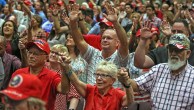Public opinion polling faced many challenges during the 2008 presidential election. None was more daunting than the rising number of “cell phone only” voters who could not be reached over the landline telephones. The latest estimates from the National Health Interview Survey — the most comprehensive measure available — suggest that nearly 18% of households are wireless only, and the NEP Exit Polls conducted on Nov. 4 found 20% of Election Day voters saying they were cell only.
To address this challenge, the Pew Research Center for the People & The Press included cell phone samples in all of its fall election polls, and many other major pollsters took similar steps. All of the Pew Research Center’s election survey reports were based on data from both landline and cell phone interviews, using a methodology described below. The addition of cell phone interviewing had at most a modest effect on estimates of candidate support in most of those individual surveys. When looked at in the aggregate, however, clear patterns emerge.

This study describes the differences between estimates of the horse race and other political measures that Pew reported this fall with those that would have been derived from surveys conducted only by landline. It also addresses the difference between supplementing landline surveys with a sample of people who are “cell only” vs. interviewing all cell respondents even if they also have a landline phone. In this regard there is growing concern that some people have come to rely so heavily on a cell phone that even though they still have a landline telephone they are virtually unreachable on it. Finally, this report describes the operational and cost issues raised by the inclusion of cell phones.
